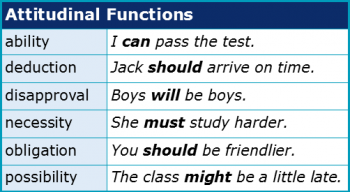Why is it important to study modal verbs?

This is the second of four chapters about Modal Verbs. To complete this reader, read each chapter carefully and then unlock and complete our materials to check your understanding.
– Discuss the importance of modal verbs in English
– Provide examples of the twelve modal-verb functions
– Explore the challenges that students face when attempting to master modal verbs
Chapter 2
Now that you should recognise the fifteen verbs and verb phrases that function as pure and semi-modals in the English language, this second chapter on modal verbs discusses both the usefulness and challenges of this word type in practice. Because it’s not possible to communicate effectively in the English language without frequently using such modal verbs, a student that wishes to become an effective academic should study this word type carefully.
How are modal verbs useful?
Because most of a proposition’s meaning is contained within a verb and its associated nouns, verbs are one of the most important word classes for speakers of English. The two sentences below, for example, demonstrate that a statement may be understood when all words other than verbs and nouns have been deleted:


As a type of auxiliary verb, and one that reportedly accounts for fifteen percent of all verb usage, modal verbs are clearly an important aspect of language learning. From an academic’s perspective, while it’s true that modal verbs are used much more commonly in speech than in academic writing, modal verbs still allow the speaker or writer to express twelve useful functions. These functions, which may be divided into attitudinal and communicative types, are provided for you below:


Why are modal verbs challenging for students?
Although there are a number of reasons that students of English make frequent mistakes when forming expressions that require the representation of modality, we’ve grouped these concerns into four distinct types.
1. Avoidance
While it may be possible to avoid using modal verbs altogether and instead rely upon modal adjectives such as ‘possible’, modal adverbs such as ‘perhaps’ or modal nouns such as ‘probability’ – all of which function as hedging language, an overreliance of these word classes and an avoidance of modal verbs will likely make a writer’s or speaker’s language appear odd or unnatural, particularly to a native speaker of English.
2. Grammar
As will be explored in much more detail in Chapter 3, the grammar of both pure and semi-modals can also sometimes confuse students with mistakes leading to a break down in communication. Because modal verbs lack the inflection of more ordinary lexical verbs, because they sometimes use present and past tense forms such as ‘can’ and ‘could’ for functions other than demonstrating a timeframe, and because (unlike other auxiliary verbs such as ‘want’) they rarely precede full infinitives using ‘to’, it’s understandable that some students make many errors with this word type.
3. Pronunciation
Modal verbs can be pronounced with strong or weak forms when used in connected speech, and because such verbs are most commonly spoken in their quicker weak forms when combined with another verb, non-native speakers of English may sometimes fail to identify them. While failing to hear or understand a modal verb may generally have little effect on overall comprehension, some structures may create the potential for confusion. If, for example, ‘can’ were missed from the offer below, the listener may instead interpret that statement as a promise:


4. Selection
Finally, as the same modal verb may be used to indicate a variety of functions, and because there may be multiple modal verbs that can indicate the same function, a non-native speaker of English may either (a) select an incorrect modal verb for their utterance, or (b) overuse the same modal verb where an alternative verb may have improved the appropriacy of their expression.
For further information about overcoming these issues, continue studying with Chapters 3 and 4 and explore the grammar and functions of modals in more detail.
Downloadbles
Once you’ve completed all four chapters about modal verbs, you might also wish to download our beginner, intermediate and advanced worksheets to test your progress or print for your students. These professional PDF worksheets can be easily accessed for only a few Academic Marks.
Collect Academic Marks
-
100 Marks for joining
-
25 Marks for daily e-learning
-
100-200 for feedback/testimonials
-
100-500 for referring your colleages/friends